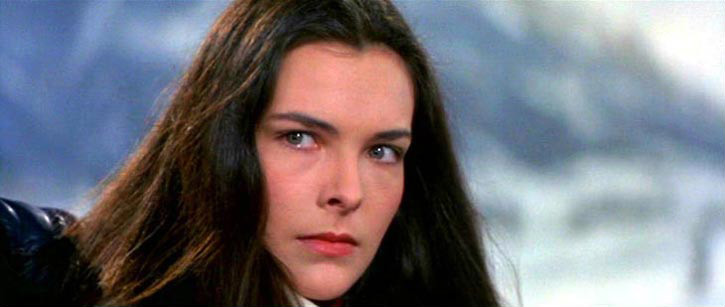
by 007hertzrumble | Apr 17, 2015 | For Your Eyes Only
For Your Eyes Only: Senescence in FYEO
By Krissy Myers (@krissy_myers)

After the extravagant and financially successful but critically panned release of 1979’s Moonraker, the creative team at EON Productions decided to take James Bond back to basics. With John Glen, a new director at the helm, 007 boldly entered the 1980’s with the straightforward spy thriller For Your Eyes Only. No more Jaws, Bondulas, outer space laser tag, implied space orgies or explicit attempts at re-entry by our lecherous but loveable Bond, Roger Moore.

“How could I bite off such a lovely face?”
Aside from a few throwaway moments, For Your Eyes Only succeeded in doing exactly what it set out to do. It was well received by critics at the time and is generally viewed as proof by Bond fans that Moore could be a serious spy when the opportunity was presented. This is how most reviews and essays praise this particular Bond film, and I’m in agreement. I’m not certain, however, that my particular reasoning behind this belief has ever been addressed in a demonstrably positive light. On the contrary, my feelings are rooted in the most ubiquitous criticism about the latter Roger Moore era.
First, a look at the opening scene.
After the gun barrel sequence, a graveyard becomes the very first shot of For Your Eyes Only. A man walks in the distance. He approaches a grave with a bouquet of red roses.

Teresa Bond, beloved wife of James Bond? She who died in 1969? James Bond’s face hasn’t yet been revealed and already we have the first overt reference to the events concluding On Her Majesty’s Secret Service presented in the Bond series to date. FYEO: not messing around! Let’s have a look at the Bond reveal, shall we?
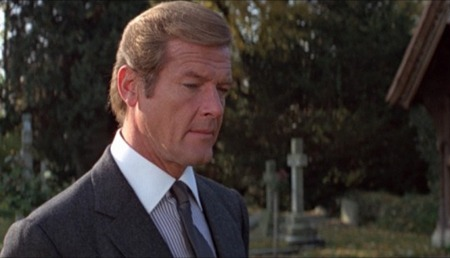
Bond looks more distinguished. Mature even. If you were a REAL detractor, you would probably say something along the lines of “Roger Moore is too old to play James Bond now.” To my beloved Moore detractors, I ask you but one question:
How old is James Bond, anyway?
Unfortunately, there isn’t a clear-cut answer to this question in the novels let alone the films. Without going into too much detail, the Literary Bond was born on or around the 11th of November in either 1920, 1921 or 1924. Others have suggested that the birth of Movie Bond remained November 11th, but later, in 1930, to match Connery’s year of birth. Without making too forceful an assertion, 1930 seems to be an appropriate choice. Not to mention, if you were to add each Bond’s respective years of birth (Lazenby being born in 1939 and Moore in 1927) and derive the average, you would get 1932. It’s safe assume then that in Dr. No James Bond was in his early to mid thirties.
With the first reference to Tracy Bond since her death, her tombstone heavily implies that the James Bond in On Her Majesty’s Secret Service is the very same Bond in For Your Eyes Only. On top of that, it’s suggested in OHMSS that this Bond was the same Bond in Dr. No and beyond when Bond was seen going through his desk. The hard date on Tracy’s tombstone along with the desk scene, indicates that James Bond was the same man in every film and series continuity up until this point occurs in real time. If we can suspend our disbelief just slightly in regards to George Lazenby’s portrayal of Bond in OHMSS and consider Sean Connery’s return to the role in 1971’s Diamonds Are Forever and if James Bond was 30-35 years old in 1962 and the Bond films happen in real time, then in 1981 James Bond would have been between the ages of 49 and 54 years of age. As I mentioned before, Roger Moore was born in 1927, which would have put him at the age of 53 at the time of FYEO’s release.

Okay, so you’re technically the right age to play Bond. Why do you have to be so smug about it?
Honestly, I have absolutely no idea whether or not that this was on purpose, but if a creative team chooses to start a film with a widowed, visibly older James Bond in a graveyard, laying flowers on the grave of his wife who passed away 12 years ago, it’s not too farfetched to assume that a motif was fermenting there: James Bond, the character and the franchise, was starting to get old. In FYEO, senescence, beyond the pre-credit sequence, isn’t something that’s explicitly explored or touched upon through the film in a superficial, “I’m getting to old for this business,” manor. That would be too jarring for an audience keen on a more youthful, exuberant portrayal of the character. Bond still scuba dives, drives cars with reckless abandon and scales steep cliffs. The notion of an aging Bond is explored in the three distinct relationships that he has with women throughout the film.
Bibi Dahl

“I said get off of me. Not get off on me.”
The one character that comes the closest to a Bond-is-getting-old joke is the precocious teenage figure skater Bibi Dahl. She seems less focused on winning Olympic Gold and more interested in seducing a much older 007. Although slightly older than her character, actress Lynn-Holly Johnson bares a resemblance to Lolita‘s Sue Lyon in physical appearance and demeanor. In an act, beyond attraction to Bond, but perhaps as self evidence of her own perceived maturity, Bibi sneaks into his room and slips under the overs of his bed, nude, upon him entering his suite. Bond made the obvious wise choice in not allowing himself to be seduced, but didn’t ignore her advances either. With the suggestion of buying an ice cream, Bond the Lothario became Bond the chaperone.
As irritating Bibi becomes, it displays Bond’s maturity as well as Moore’s penchant for chivalry (as mentioned in my previous My Favorite #Bond_age_ essay for The Spy Who Loved Me), considering the young lady’s needs and desires. Despite Bond, well, being Bond, he understood that Bibi probably was just looking for attention from someone older. That’s something many teens, my teenage self included, do for a variety of reasons. Rather than take advantage or ignore her totally, Bond indulges her in a non-threatening way, if only somewhat begrudgingly. It was a very paternal gesture on Bond’s part, which would have probably played out differently had Bond been younger.
Countess Lisl von Schlaf

“Side boob? I’ll give you more than side boob.”
The scenes between Bond and Countess Lisl von Schalf serve as the most typical 007 relationship in FYEO. The perceived villain sent his mistress, Lisl, to seduce and extract information from James. It wasn’t a great deviation from previous Bond films aside from Lisl being a more mature woman. The “nightie” exchange conveys a tinge of nostalgia and a common origin shared between her and Bond.
“Oh, my nightie almost slipped!”
“So did your accent. Let me guess, Manchester?”
“Almost. Liverpool.”
Both were older, from the same country and took an instant liking to each other: each a respective beacon of familiarity among the exotic locals and pretty young things in the movie. The Countess is a breath of fresh air for Bond and the pacing and tone of the film, at least initially. An easy going, assured, mature lady who stays up at night and has champagne and oysters sitting in her fridge, making it all too easy for Moore’s Bond to do what he does best: be a magnificently smooth bastard. Not to mention, Bond has always been fond of falling into an obvious trap. No wonder he seemed so despondent when he found Lisl dead on the beach. His scenes with Lisl were really the only part in the film up that point where he got to have any fun.
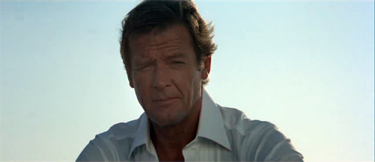
“Goodbye, Countess.” Aww, Sad Bond is sad.
One character in particular probably wasn’t entirely sad when the poor Countess met her untimely end.
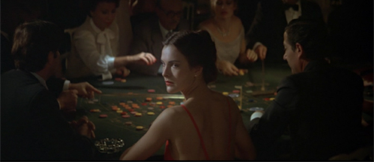
The above is a shot of Melina at the casino, watching Bond leave with Countless Lisl. She wasn’t too thrilled about it.
Melina seems to be a sort of middle ground between Bibi and The Countess in age and in terms of how she interacts with Bond. Their relationship begins as mostly platonic and remains that way for the majority of FYEO, but by the end, they engage in one of the more beloved Bond tropes: making whoopee on a boat. Something about this particular Bond film, which presses on my mind, is this: why did Melina and James suddenly end up getting romantically involved at the end of FYEO? Was it merely because it was a prerequisite for a Bond’s Belle Du Jour to have sex with 007 at some point during the film or was there a deeper reason for it?
The other and much more prevalent motif in FYEO is revenge; avenging Tracy’s death in the pre-credit sequence against not-Blofeld and the driving force behind Melina’s character in getting revenge for the death of her mother and father. Melina and Bond initially cross paths because Melina’s father was contracted by MI6 to retrieve the ATAC machine (the movie’s McGuffin) before the Russians. After a few close calls and an unglamorous car chase with the Citroen 2CV, Bond and Havelock… wax poetic on the nature of revenge?
“The Chinese have a saying: Before setting off on revenge, you first dig two graves.”
“I don’t expect you to understand, you’re English, but I’m half Greek and Greek women like Electra always avenge their loved ones.”
Certainly Bond was very knowledgeable about revenge. He was more than willing to share such knowledge with Melina, but not anything, which may be concealed in his pants. They meet several times throughout the film and rather than Moore taking Havelock back to his room for some sexy time, he advices Melina to essentially, stay out of harm’s way. Moore’s chivalrous, paternal instincts rear their head once more.
Melina’s mention of Electra was interesting as well. Sure, she was of Greek origin and it was an apt comparison, but in my observations, any mention of Electra in this sort of context tends to be shorthand for Daddy Issues in modern popular culture.
A capable, mature-for-her-age woman becomes fixated on an older, even more capable, sophisticated man due to deep-rooted issues, usually involved with death or abandonment, with their Father. It’s an old trope that fits neatly in FYEO. Melina was a capable, mature-for-her-age woman avenging the death of her Father; and Bond was an older, capable and sophisticated man. Moore’s Bond especially fits that description. It was a deep and radical prospect for Melina (and I suppose to an extent Bibi as well), to be sexually attracted to James for reasons beyond him being a sexy, vigorous man’s man. I think that the creatives on this film realized that this was a little more difficult to pull off with an aging Roger Moore. With Bibi it was played for laughs, but with Melina it was a little subtler – just dim enough for audiences not to notice right away.
The screen shot I used to show Melina’s disapproval of Bond leaving with Countless Lisl makes a bit more sense now, doesn’t it? Bond played adviser to her throughout the film and for reasons I cited previously, it was not too much of a stretch for her to become attached to him. To have had someone like Bond so readily fill that gap at a point where she was psychologically compromised with avenging her parent’s death, it wasn’t especially unusual for them to finally hook up at the end once Kristatos was finally killed by Colombo. There was even a nifty deleted scene where James returns to Melina’s boat and she brings up his rendezvous with the Countess (which can be viewed here at the 2:15 mark if you don’t own the BluRay: http://www.youtube.com/watch?v=z1c-Q0-w76Y)
“I called your hotel. You weren’t there.”
“Didn’t get back there last night.”
“I’m not interested in your sex life, Mr. Bond.”
“My sex life is not what I came here to discuss.”
Oh yeah, she went there. Bond wasn’t pursuing Melina. Melina was pursuing Bond. While she succeeds, it’s still extremely interesting that Bond went for only the most mature, sophisticated lady right away. That was a definite hallmark of his age.
Ultimately what I’ve been trying to express is this:
Not only did Roger Moore’s Bond work because he was older, but his age lends gravitas and complexity to the role.
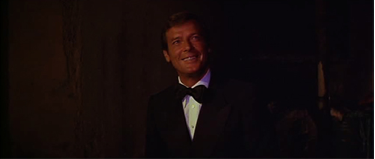
“Thank you, Krissy.” You’re welcome, Roger.
He was too busy, too focused and too old to lightly fool around with pretty young things. Bond simply wanted to get the job done. This cooler, but still sympathetic, witty and chivalrous portrayal served as the one moment in his tenure where Moore managed to strike a balance between Ian Fleming’s pensive and melancholy Bond of the novels and his own personal interpretation. Roger may have found himself in the role in The Spy Who Loved Me, but it was in For Your Eyes Only where he truly mastered the character and successfully took Bond to a place where he’d never been before: over the hill. I understand why that might make some Bond fans feel a bit uncomfortable, but maybe the reason contemporary Moore detractors cite his advancing age as a flaw is routed in personal tastes and beliefs. I feel that this criticism is a bit shallow and does a disservice to Bond’s credibility as a character. It’s the only reason I can think of that Bond fans have the audacity to dictate that Bond cannot be a convincing and compelling sexy super spy because of his age. James Bond is more than a serial womanizer, cheap thrill and license to kill. Roger Moore and For Your Eyes Only went above and beyond in proving that.
First Bond Movie: Thunderball.
Favorite Bond Actor: HAH!
Favorite Bond Girl: Teresa Di’Vicenzo from On Her Majesty’s Secret Service. Guilty pleasure goes to Pam Bouvier from Licence To Kill.
How I Discovered #Bond_age_: Through the James Bond tag on Tumblr.
First #Bond_age_ Live Tweet: Strangely enough, The Spy Who Loved Me. How appropriate!

by 007hertzrumble | Apr 13, 2015 | GoldenEye, My Favorite #Bond_age_
GoldenEye: Propelling Bond into the Future Since 1995
by Becca Andrews (@R_ViewMovies)

From 1989 to 1995, the world went six years without a Bond movie. Timothy Dalton hung up the Walther PPK after just two films. Pierce Brosnan was cast as his successor, with Martin Campell directing. GoldenEye proved to be a sure fire hit, rebooting the long running spy franchise and cementing James Bond 007 as the man for the moment (or last three decades) once again.
GoldenEye added a new ingredient to that famous 007 recipe for success. If you feel that things have grown stale, simply wait 4-6 years for the global cultural/political stage to shift slightly, cast a new face in the role of Bond and get Martin Campbell to direct. Your Bond film will be a success!
The biggest question facing the first post-cold-war Bond film was – Is 007 still relevant? The fact that Skyfall became the highest grossing film of 2012 and overtook Thunderball to become most profitable Bond film of the series so far has perhaps proved that yes, Bond is still relevant… perhaps more relevant than ever, thank you very much.
GoldenEye is my favourite Bond film for precisely this reason. Martin Campbell takes all the well-worn elements of the Bond formula and puts a fresh spin of them, resulting in an exciting and memorable chapter in the series. Brosnan’s subsequent films tried but arguably failed to live up to the same standard. If it wasn’t for GoldenEye’s success, the future of the franchise may have been called into question. If it wasn’t for GoldenEye, would we still have Bond?
Every so often, like Doctor Who, 007 gets a new face. Arguably, the only constant is the famous “Bond formula.” To paraphrase three-time 007 director Lewis Gilbert, there’s a “law of Bond,” and fans expect the films to abide. The formula suggests that a successful Bond film must contain certain ingredients. Beautiful women/sex, exotic locales, evil villains and gadgets. And to a great extent, Gilbert speaks the truth. So it might be useful to explain why GoldenEye is my favourite Bond by looking more closely at these crucial elements.
Girls: Bond has a hat-trick of ladies in GoldenEye, namely Caroline (Serena Gordon), Xenia Onatopp (Famke Janssen), and Natalya Simonova (Izabella Scorupco). The immortal Dame Judi Dench famously joins the franchise to portray the new M, reflecting the fact that Stella Rimmington had recently taken over the role in real life.
M famously calls Bond a “sexist, misogynist dinosaur, a relic of the cold war” and to a certain extent, I would be inclined to agree. There are many remnants of the Connery-era Bond left in GoldenEye – but there has been a changing of the guard. And although we see woman in positions of power, a true femme fatale stereotype still rises to the forefront. It’s Xenia who uses sex to kill, further threatening the hierarchy and therefore must be put down, allowing Bond to bed Natalya, the film’s ideal woman.
Exotic locales: Bond does a fair bit of globe-hopping in GoldenEye, taking us to St. Petersburg (Russia), Monte Carlo (Monaco) and Cuba, although of course many of the interior shots of the Russian scenes were filmed in and around London. Fleming himself was well travelled and during the 1960’s when both package holidays and the Bond films were taking off many cinema-goers were treated to a virtual world tour for the price of their cinema ticket.
Villains: GoldenEye has an interesting villain in Alec Trevelyan (006) played by Game of Thrones and Lord of the Rings star Sean Bean. Trevelyan is later revealed as Janus, the film’s main villain with plans to steal the GoldenEye, a satellite-based EMP. As with Janus’ two faced nature, the film has many nods to the past whilst bringing the franchise into the modern era. More memorably, the film’s aforementioned female baddie – the thigh crushing, brilliantly named Xenia Onatopp. She’s obviously oversexed and harvests pleasure from giving people “a good squeeze.” As with the world of Bond, the more bizarre the better. Skyfall’s Silva has nothing on her!
Cars/gadgets: The Bond films have often been at the forefront of technology but also absurdity (Octopussy’s alligator boat, anyone?). GoldenEye sees 007 driving a weapons-laden BMW Z3 roadster and the iconic Aston Martin DB5. Gadgets include a piton gun, a leather belt with a rappelling cord in the buckle, a pen that’s also a class-4 grenade, and a laser-emitting watch that is also an arming device.
GoldenEye is very much of its time – a 90’s Bond for 90’s sensibilities. Although we’d like to think Bond has progressed since then, the films that followed suggest it may just be a pipe dream – although Skyfall may be the exception. GoldenEye has resounded so strongly with me as a Bond fan because it retains all the classic elements of the Bond films while updating them for a modern audience. It stands the test of time by recalling the past, but also propels Bond into the future.
First Bond Movie: In the cinema: Tomorrow Never Dies. On TV: A View To A Kill.
Favorite Bond Actor: Moore. Daniel Craig comes a very close second.
Favorite Bond Girl: Octopussy, embodying women’s lib despite being a criminal mastermind (plus Maud Adams is the most prolific Bond girl, appearing in 3 – yes, 3 – different films as 3 different characters!)
How I Discovered #Bond_age_: the wonderful world of Twitter.
First #Bond_age_ Live Tweet: I’ve yet to participate due to the pesky time difference.

by 007hertzrumble | Apr 13, 2015 | Skyfall
Skyfall: The Significance of 50, The Power of 3
By Tim Romines (@TimRomines76)

When Skyfall was released last year, there were a couple of numbers that received a lot of publicity. One of those was 23, as in the twenty-third film in the EON produced James Bond series, an impressive achievement that is unlikely to ever be duplicated, especially considering the sometimes radical changes in tone that each lead actor, writers & directors brought through the various eras. Of course, the other much ballyhooed number was 50, marking the Golden Anniversary of Ian Fleming’s secret agent on the silver screen and, thus, cementing 007’s status as an enduring pop culture icon that will likely exist in some form forever.
As important and historic as those numerals are, the number that will stay with me whenever I think of Skyfall is 3. That figure represents the generations who sat in a packed, state-of-the-art auditorium in Knoxville, Tennessee anxiously awaiting the further adventures of Agent 007. As I sat there between my dad, Doug & my son, Drake, I was struck by the sentiment that this was the way it was always meant to be; sharing the action & thrills of a Bond film with people you relish spending time with and having a superb time doing it. I became acquainted with James Bond by watching with my dad, my son picked it up from me and now here we were, together among other folks with a communal love for this character, wondering where his latest excursion would take us. As the lights were lowered, I felt like we might be in for something special and I’m delighted to say I was right.
Let’s Do The Time Warp Again
From the excellent introductory shot of an out of focus Bond, accompanied by the familiar musical cue, to Adele’s lush & gorgeously haunting theme, (which, considering my mood on any given day, is constantly battling Paul McCartney’s Live And Let Die for the number two spot, since Dame Shirley & Goldfinger sits firmly on top of my favorites list), all the way up to the magnificent, goose bump raising denouement, (more on that in a bit), Skyfall succeeds by paying just the right amount of respect & homage to all that came before, while continuing to move the franchise in the only logical direction it can go. Yeah, yeah, I know that some of the tributes in this movie made no sense continuity wise, (I’m looking in particular at the Aston Martin DB5, in spite of its unveiling being a highlight moment for me personally), but let’s be blunt, EON has never made tight continuity a high priority in this franchise anyhow. That being said, I chose to just go with it & enjoy the ride, timeline glitches and all; I feel that was a wise decision. The classic elements are all there; a menacingly memorable villain, the ill-fated love interest, the mind-blowing stunts, top-notch scoring and the gorgeous scenery that are Bond hallmarks. We are finally reintroduced to beloved characters, albeit revamped & reimagined, such as Miss Moneypenny & Q, along with a new take on the classic M. However, this story takes the narrative into uncharted waters that I absolutely adore. We get intimate portraits of Bond, deeply delving into his troubled, unfortunate past for the first time in five decades, and we get distinct, plausible looks into what make M & Silva tick, making their actions all the more relatable. Silva, (Javier Bardem, chewing scenery & clearly having a ball), isn’t trying to take over the world akin to assorted SPECTRE, SMERSH or Quantum schemes. He simply wants revenge on the one person whom he feels betrayed him, (she did), and will rack up as much collateral damage as it takes to get said vengeance, (he does). The exploration of his failed professional relationship with M, (played to the bitter end by the legendary Judi Dench), especially when compared with the total trust, respect &, (dare I say it?), love she ultimately shares with Bond, is heartbreaking, compelling and eventually leads to a tragic culmination to their story. In fact, how they both failed to receive Oscar gold based solely on their face to face confrontation scene at MI6 will forevermore remain a mystery to me. Silva’s gut-wrenching revelation of his emotional, mental & physical scarring, (as well as M’s & Bond’s reactions to it), is chilling, disturbing and played to perfection on every hand. With Silva, we view the twisted reflection of whom Bond could have easily became in the right circumstances, were he a man of lesser convictions, and that is simply brilliant. It makes him one of the most complex and convincing rogues in Bond history.
And What of Bond Himself?
Yes, this film has been criticized for being pitch dark at times but there are also moments of levity that are organic and genuine and it serves the story well. Case in point, the museum exchange between Bond & Q is funny, clever and oddly poignant but never induces the eye rolls that some Bondian humor has in the past; I could recite examples all day but I will spare you from such unpleasantness. Daniel Craig is still brooding and cynical, (the same recollection of Fleming’s literary Bond that Timothy Dalton was so unfairly criticized for in the 80’s), but here he finally looks utterly comfortable in 007’s skin and I feel that this is the film that silenced most doubters for good. I’ll say it boldly, Daniel Craig is not a place holder, he IS James Bond, (as much so as Sean Connery), and he has redefined an icon for a new millennium. His portrayal has, thankfully, reestablished Bond as a relevant, contemporary action hero, whilst restoring credibility to a character that has been oft abused in the past. Candidly, I feel for whoever is tasked with stepping into his shoes when he departs the role and that’s the supreme compliment I can possibly grant him. Oh, having said all of that, let us please discuss that final scene. When we get the splendid shot of James looking over London, his city, with flags flying and stirring music in the background, we are reminded that true patriotism isn’t about pushing various political agendas, whatever they may be, but is rather the unwavering belief that you live in the greatest country on the planet, wherever that may be, and aren’t afraid to admit it or embrace it. In a nutshell, this encapsulates what I sincerely love about Commander James Bond; Girls, gadgets & catchphrases aside, 007 loves his country and will defend it, and its citizens, with his last breath and that, my friends, is the definition of a hero. Finally, in my humble opinion, anyone who wasn’t thoroughly geeked at the concluding image of M sending Her Majesty’s Secret Service Agent 007, (licensed to kill), off to his next exploit should probably turn in their Bond fan cards. Straightaway.
When the film was over, amid the elation and applause, I looked to either side of me and was exceedingly grateful to have shared this experience with two of my favorite people on Earth, (I’m getting a wee bit choked up as I write this now). We were thrilled by what we had seen and proceeded to critique the film on the ride home, pointing out our favorite bits. We all agreed that it was time well spent and, in the end, isn’t that the entire point? Looking back, I can’t help but ruminate that moments…memories…just like that will be exactly what keep James Bond valid for 50 years more and well beyond. Thanks Mr. Fleming, we are forever in your debt.
Tim Romines (@TimRomines76) is a husband, father, chef & infrequent blogger, (in that order,) living in the shadows of Rocky Top in East Tennessee. His interests are so varied, they border on absurdity, but food, superheroes, Sci-Fi, horror &, of course, James Bond are but a few. You can read his semi-coherent ramblings at rominesrants.tumblr.com
First Bond Film: Moonraker. I came back in spite of that.
Favorite Bond: With immense respect to all actors involved, Connery & Craig are tops for me.
Favorite Bond Girl: Contessa Teresa “Tracy” di’Vicenzo Bond (Diana Rigg) & Vesper Lynd (Eva Green). So much more than helpless victims, they were smart, clever & brave. They won Bond’s heart and that makes them special.
How I discovered #Bond_age_: When I first joined Twitter, I was searching for Bond content & @007hertzrumble was among the first things to pop up. I thought it all sounded extremely fun & here we are.
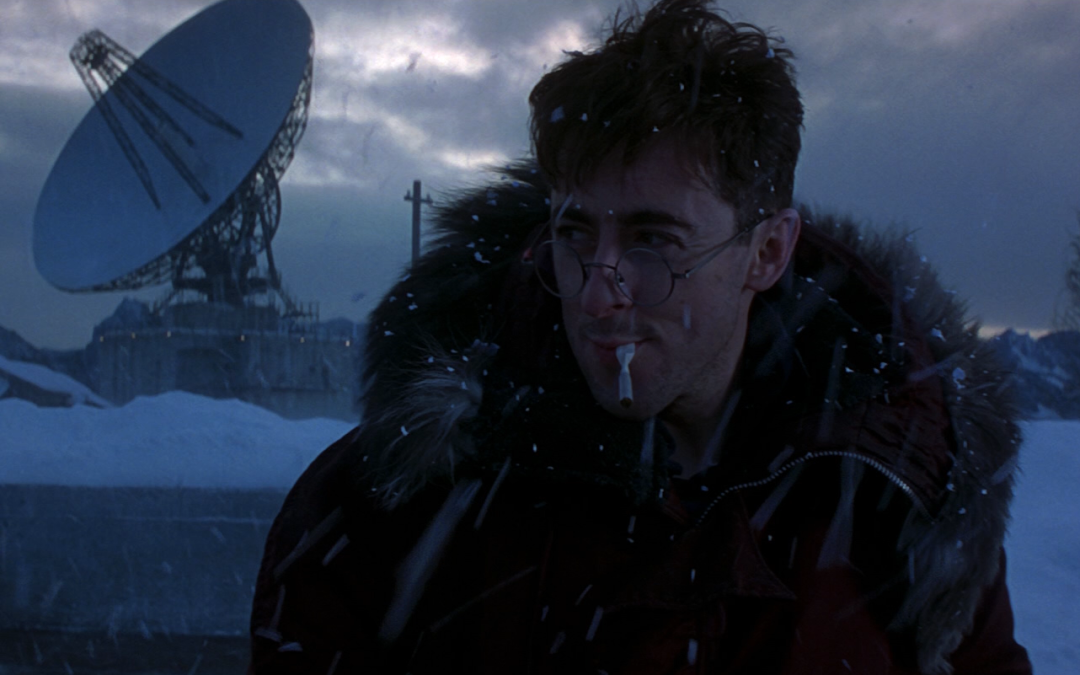
by 007hertzrumble | Apr 13, 2015 | GoldenEye, My Favorite #Bond_age_
GoldenEye: The First Resurrection
by Nicolás Suszczyk (@NSuszczyk)

In Skyfall, Daniel Craig’s James Bond says to an overjoyed Silva his hobby is “resurrection”. Of course he resurrected in Skyfall after a not so bright Quantum of Solace and in Casino Royale after the somewhat grotesque Die Another Day. But the first resurrection 007 has ever had was, without a doubt, the 1995 film GoldenEye.
I was seven and a half years old when I saw a graphic ad in Buenos Aires announcing the cable TV premiere of GoldenEye in December 1997 or January 1998. Against a white background, there was a good-looking fellow in a tuxedo holding a silenced Walther PPK handgun, in an image lifted from the film’s teaser poster under the tagline “you know the name, you know the number.”
I didn’t know the name. I didn’t know the number, but that campaign forced me to learn more. I’d also heard once before some people in a toy store playing the famous GoldenEye game on a Nintendo 64 telling me this was the “agent 007 game.” After my dad gave me some Bond backstory, on January 31st 1998 we watched the film on TV. Multiple things happened to little Nicolás Suszczyk there: I went wow when I saw the hero shooting the audience through a gun barrel. My eyes opened wide when the same man bungee-jumped over 700 feet from a dam, and, of course, I fell in love with Famke Janssen, now the only woman over 45 I would think of dating.
GoldenEye ushered in a new generation of Bond fans and introduced the Cold War secret agent to the last leg of the 20th century. It showed Bond can still survive and arise with success in a generation of Internet and cellphones and that he didn’t really need SPECTRE or the Soviet Union to exist. Of course, the film has taken full advantage of the end of the Cold War, and they didn’t hide the fact (some sort of in-joke maybe) that 007 was a “relic of the Cold War” — a notion perhaps only exacerbated by the more than six-year hiatus where everybody thought Bond was dead after the poor box office for 1989’s Licence to Kill.
The remarkable direction of Martin Campbell (who has never disappointed me with any film, inside or outside Bond), the sharp photography of Phil Mehéux, Terry Rawling’s breathtaking editing and of course, the vivid imagination of the late Michael France who choreographed the unforgettable face-off between two double-oh agents. Bruce Feirstein and Jeffrey Caine turned France’s script into the the exquisite final recipe for GoldenEye, made even better with Pierce Brosnan, Sean Bean and Judi Dench in the cast. I even like Eric Serra’s score. Of course it has many flaws, but those metallic pings and pops capture the essence of the film, not to mention its time and place. As does the score for the epic tank chase by John Altman and the end title song “The Experience of Love,” which fits the triumphant feeling of the film’s romantic ending.
GoldenEye is the Bond film that has it all: the inclusion of the Internet in a Bond film with a small pinch of a Soviet Union Cold War dread sprinkled about, explosive and breathtaking action scenes, a solid script dealing with Bond’s emotions not only toward women but toward friends, an innocent and lovely girl in Izabella Scorupco, a sadistic sex-bomb in Famke Janssen, a charming but evil rouge agent in Sean Bean and of course, lots of humour with Robbie Coltrane and Alan Cumming.
Want to jump into the Bondwagon? Need a good introductory film to watch? Start with GoldenEye.
Nicolás Suszczyk was born and lives in Buenos Aires, Argentina. He became a James Bond fan at eight He studies journalism and runs the 007 fan sites The GoldenEye Dossier and Bond En Argentina.
First Bond Movie: GoldenEye on TV, Tomorrow Never Dies on the big screen.
Favourite Bond Actor: Pierce Brosnan
Favourite Bond Girl: Eva Green to marry, Famke Janssen for an occasional fling.
How I discovered #Bond_age_: Discussing Bond with unknown people worldwide.
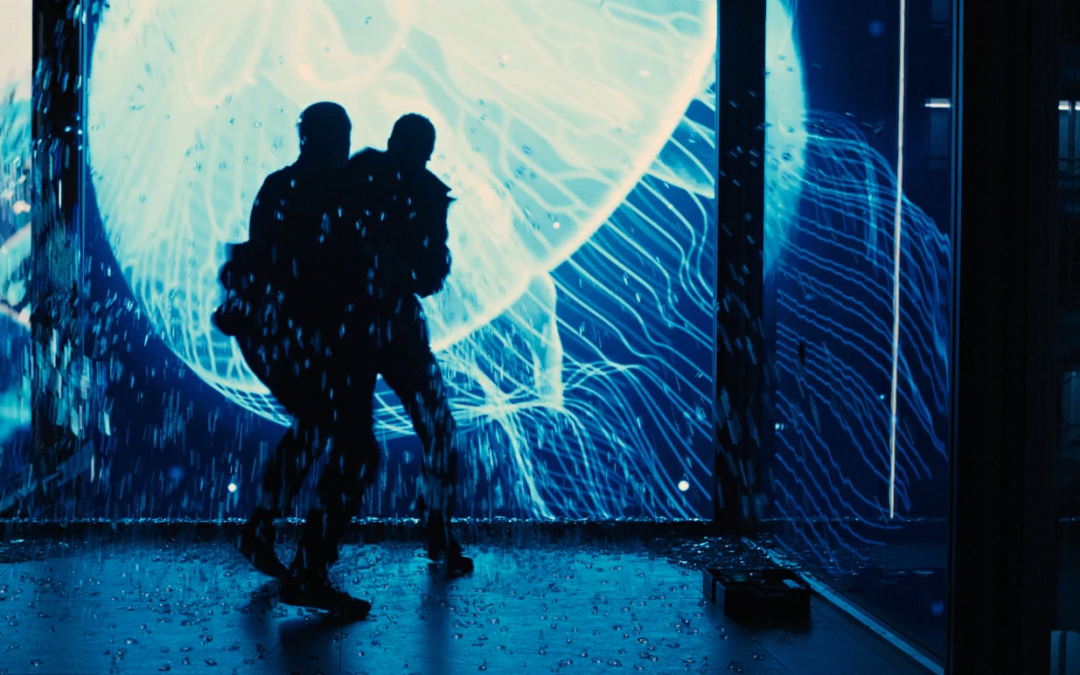
by 007hertzrumble | Apr 13, 2015 | Skyfall
Skyfall: James Bond, 50 Years Young
by James Tracey (@JamesEditsFilms)
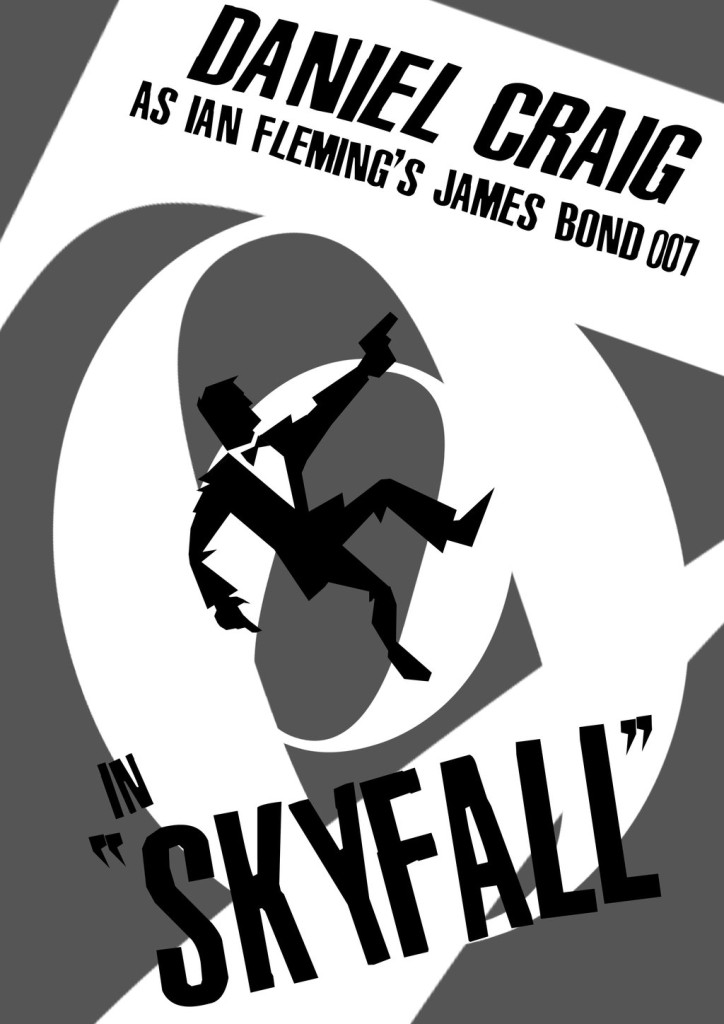
“I like to do some things the old-fashioned way.”
“Sometimes the old ways are the best.”
After 50 years, you would think we’d eventually tire of James Bond. But something about the way the films have evolved and grown over the decades, and still fundamentally remained the same, has left us coming back. We may not love every film of the series, but we have remained loyal through and through. But I’m sure a lot of us have felt the growing age of the series at one point or another.
Skyfall tackles that age head-on. Unlike the tail ends of the Connery or Moore films, Sam Mendes entry into the Canon makes no attempt to hide the age of the series or its star, Daniel Craig, who was (and still is) 45 at the time of the film’s premiere. Most of the film centers on a battered and bruised 007, whose alcoholism and age is proving to be limiting. He’s not as strong anymore, he’s not as fast as he once was, and he can’t even shoot straight. Like the grand, old warship being hauled off for scrap, Bond is feeling the inevitability of time. The only question that remains is whether Bond can endure in the post-cold war environment.
For most of us here at #Bond_age_, we can answer that question with a big fat “DUH”. We love Bond so much that we’ve dedicated a day a week to watch and celebrate a Bond movie. We will probably keep doing for years to come. We celebrate this series because the films offer glimpses into the eras they inhabit. But Skyfall is a film that joins that celebration while still fearlessly leaping forward into the future. Gone are the exploding pens of yesteryear, which are replaced with DNA encoded guns and radios. But the essence of the series remains intact.
Skyfall is ever faithful to its roots. Take, for instance, the film’s antagonist; Javier Bardem’s Silva embodies the spirit of a classic Bond villain. His plans are big, epic and even a tad nonsensical. He has a terrifying back-story that has left him with a disfigured face in a return to the same spirit as Blofeld. His reveal shot and monologue is the kind of moment made only for a Bond villain. For chrissakes, his lair is a giant, abandoned island! Yet he inhabits the type of crypto-warfare that is all too popular within our modern Hollywood films. He’s a hacker who works out of sight, and can effectively be anywhere at once. He represents the threat of cyber terrorism; a threat that is all too common post-9/11. He is the modern and classic villain. He’s the best of both worlds
Bond, on the other hand, is struggling with his sense of self. Still shaving with a straight razor and MI6 is feeling the pressure from higher ups. In a world with no shadows, what use is there for a man like Bond when they have agents that can do all their work from a laptop in nothing but pajamas? Evolving with the times has always been a challenge for the Bond series. There was something so self-assured in the 1960s films that could arguably never be fully recaptured. By the 70s, the formula established by Goldfinger was already feeling a tad stale. Anyone remotely familiar knew the usual Bond trappings: Bond wraps up a previous mission, gets briefed by M for next mission, he investigates, sleeps with women, Bond gets captured, escapes, sleeps with more women, then beats the bad guy, and gets the girl. Wash, rinse, repeat. There was always some wiggle room and the series still produced gems from time to time, but for the most part, it was starting to get old.
When Bond got the reboot, it was long overdue and it felt fresh and reinvigorating. But to some, it wasn’t the James Bond we once knew. The series had been suffering from an identity crisis for a long time, but long-time fans really took note after the paltry reception of Quantum of Solace. But Skyfall eased their conscience. The film plays the familiar beats that series has been known for, but it somehow made them feel fresh and shiny again. James Bond and MI6 both embrace their former glory and how it has come to define them. “Made weak by time and fate, but strong in will; to strive, to seek, to find, and not to yield”. Bond and M of course hop into the legendary 1963 Aston Martin and drive to the crumbling estate where Bond was orphaned. A tragic past that has come to define the character we know.
The film also takes substantial opportunity to explore the working and personal relationship between Bond and his well-known superior M. by casting Judi Dench in a more motherly role this time around, Skyfall finds its heart in the relationship between the pair. As the two look over the beautiful scenery of Scotland, their conversation isn’t one of business. The subject is Bond and his life before the agency. M’s remarks are hollow on the surface, but it is Dench’s delivery where she finds something truly personal between the two characters. This dynamic helps build up one of the series most heartbreaking finales. And the series has had its fair share thus far.
One of the hallmarks of the 23rd entry is the breathtaking cinematography provided by the legendary Roger Deakins. The use of lighting and color is so crucial to this film’s success, that it is even used as a plot point: Bond keeps his presence unknown from an assassin by hiding behind the shimmering glass that is reflecting the light of Hong Kong. The single take of the fighting silhouettes that follow shortly afterwards is technically flawless. And as Bond enters the casino in Macao, it is nothing but sheer visual bliss. Even the simplest scenes look beautiful, like M’s office. Skillfully winking towards the stylized 60s office and giving it a modern feel through by its framing and lighting.
It’s within this final scene of the film where everything comes full circle. Once Bond has dealt with the terrorist threat once and for all, and has proven his worth to the British Intelligence, he walks into the room all too familiar to Bond alumni. A scene the casual Bond fan would find rather unremarkable, but to us, it is punctuation of the film’s thesis statement. To see the scene unfold on opening weekend stunned me to my core. I walked out of the theater with the biggest grin on my face. If James Bond was brought back from the brink in 2006, then it was with Skyfall that his resurrection was complete.
I’m always at a loss for words when someone asks me the dreaded question: “What’s your favorite James Bond film?” I mean there’s so many I can make a case for. I wish I could say all of them. Skyfall is the Bond film that lets me celebrate the series as a whole, and allows me to look forward to a future where James Bond continues to dominate the popular culture landscape like no other hero before. For 143 minutes, I find myself in utter Bond heaven, and I smile with glee when the credits role and those familiar words grace the screen:
James Bond Will Return.
First and foremost, James Tracey (@James_at_movies) is a movie lover. Not the oldest of Bond fans, he is of vocal one. He studies film in his native city of Windsor, Ontario, writes periodically for www.zombiesquirrel.com (@ZombieSqwrl ) and edits films like this one (https://www.youtube.com/watch?v=4tGcdODpmkI). Also, he LOVES cats.
OTHER Favorite Bond Films: *Takes a deep breath* “Dr. No”, “From Russia With Love”, “Goldfinger”, “Thunderball”, “You Only Live Twice”, “On Her Majesty’s Secret Service”, “The Spy Who Loved Me”, “Goldeneye” AND “Casino Royale”
First Bond Film: Tomorrow Never Dies
Favorite Bond: Changes daily. Today it’s Timothy Dalton
Favorite Bond Girl: Diana Rigg. Hands Down.
How I discovered #Bond_age_: Don’t remember how it happened, but Scott Weinberg (@ScottEWeinberg) definitely had a supporting role

by 007hertzrumble | Jun 1, 2014 | #Bond_age_ Project, Casino Royale
Casino Royale is the 21st essay in a 24-part series about the James Bond cinemas. I encourage everyone to read the other essays, comment and join in on the conversation about not only the films themselves, but cinematic trends, political and other external influences on the series’ tone and direction.
(Welcome, Snoopathonners!)
Of [In]human #Bond_age_ #21: Dispatching the “Reboot” and the Derring-Do of the many Casino Royales
by James David Patrick
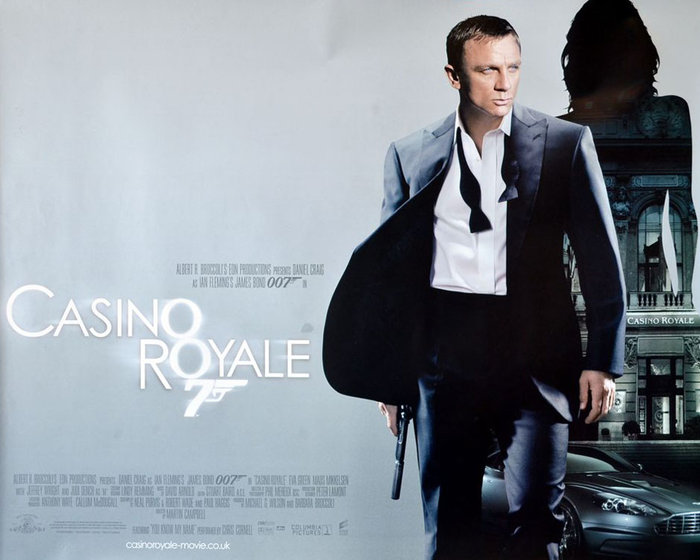
The term “reboot” first became buzzworthy in 2005 when Christopher Nolan begat a new Batman universe only eight years after George Clooney last donned Joel Suckmaker’s bat nipples. The word “remake” had become tarnished from frivolous overuse and poor decision-making and synonymous with the industry’s dearth of creativity, or perhaps more appropriately, trembling risk averseness. As what can only be seen as a sly marketing ploy, the term “reboot” replaced “remake.” The term, of course, wasn’t a Hollywood original. True to form, Hollywood, the great appropriator (and/or corruptor), borrowed “reboot” from the comic book industry, which had, in turn, borrowed it from the computer science industry. “Reboot” derives from the idiom to “pull oneself up by the bootstraps” – an apt description for what happens when a franchise finds itself at the bottom of a creative well. (more…)





















